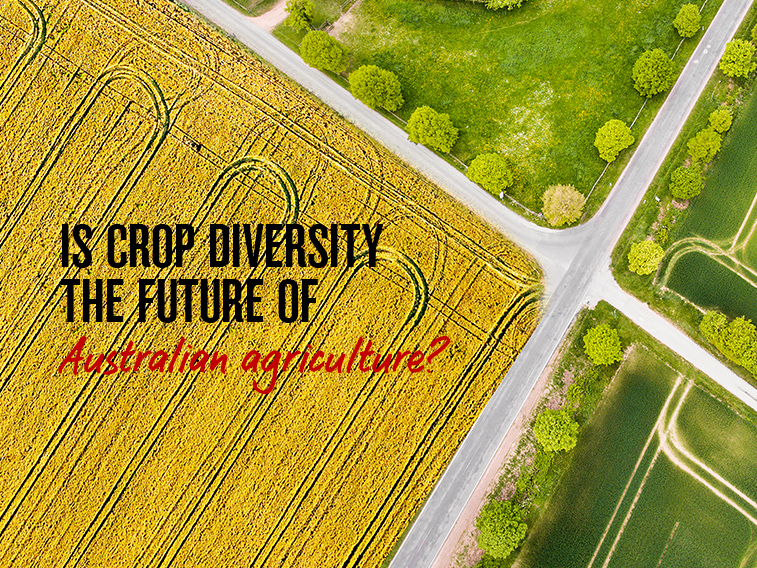The latest NAB Regional & Agribusiness webinar provides insights on the Australian & Global Economies, and a regional and rural property update. Watch the webinar here.


Timothy Reeves of the University of Melbourne discusses why there’s a real opportunity to grow a wider range of crops and build a more sustainable Australian agriculture model.

Lack of diversity in food crops could be a threat to some farmers as well as to food security on a global scale. Professor Timothy Reeves of the University of Melbourne discusses why there’s a real opportunity to grow a wider range of crops and the steps Australian farmers can take now to help secure their future income.
What would happen if a new strain of disease wiped wheat off the planet? Or we could no longer grow maize or rice?
“A hit on any one of them would certainly have an impact on global food security,” says Timothy Reeves FTSE, Professor in Residence at the Dookie Campus of the Faculty of Veterinary and Agricultural Sciences, University of Melbourne. “Together, these three cereals provide over 50 per cent of the world’s plant-based calories – 20 per cent come from wheat alone. And, overall, 85 per cent of global food production depends on as few as 12 species of plants and five species of animals. There are over 5,000 plant food species available, but we use so few of them.”
Along with the global threat, Reeves believes lack of diversity is also putting some Australian farmers at risk.
“Where I work in north-east Victoria, one canola variety dominates about 80 per cent of the area farmed,” he says. “Again, a disease or pest could be very damaging.”
Many farmers are already embracing the idea that a wider range of crop and livestock choices would provide a hedge against such an event, Reeves says. He also cites two more good reasons why a broader approach to planting could set farmers up for future success – greater sustainability and better-quality soil.
A more sustainable future
Reeves argues that, around the world, regions producing wheat, rice and maize are already under considerable duress.
“Climate change, water availability and competition for both land and water from urbanisation and population growth are some of the main threats to sustainability,” he says. “Some neglected crops such as millets, sorghums, teff, chickpeas and lentils have proved to be very good foodstuffs in certain areas, as well as being more tolerant to heat and drought. In Australia, there’s clear evidence that greater crop diversity makes sense in terms of farmers’ profitability and productivity.”
Enriching the soil
Over 50 years’ experience in agricultural research has taught Reeves to see sustainability as a ‘moving target’.
“For example, we now know that the wheat/canola rotation that dominates farmland from Western Australia through to the eastern seaboard isn’t sustainable because it’s reducing nitrogen and carbon levels in the soil,” he says. “As a result, farmers need to add more and more expensive fertiliser to maintain yields. Yet something as simple as planting pulse crops such as lentils, chickpeas, faba beans and lupins is a tried and proven way of sparing nitrogen use, whilst legume-based pastures grazed by livestock can not only increase soil nitrogen but also help to build carbon in the soil.”
Some growers are put off by the problems that arose when a similar rotational system was widely used in the 1960s, 70s and 80s.
“It’s true there were a number of challenges back then, such as soil acidification, soil compaction and root diseases being carried from grasses in the pasture into wheat, but we now know exactly how to deal with all of them,” Reeves says. “Good data developed by CSIRO and other groups shows that, if you look beyond annual returns to a five- to seven-year period, the inclusion of legumes is profitable, particularly if you add livestock.”
A conservative approach
For all that, Reeves understands why many farmers remain very cautious in their approach to change.
“Quite rightly, growers are risk averse,” he says. “They’re also right to argue that pulses can perform less well than the crops which attract the lion’s share of research investment. But we do know that many farmers are growing them very successfully as part of their systems.”
Some growers are even returning to a modern version of the age-old practice of leaving paddocks fallow – not planting them at all for a season.
Reeves’ contacts in the farming community say the positive effects of ‘no-till’ fallowing can justify the loss of a year’s production. “Those with large cropping operations say that, by being more timely and paying more attention to the paddocks they are putting into crop, they’re achieving an increased yield that counters any negative effects, as well as providing them with an effective climate risk management tool,” he explains.
NAB supports positive change
In August, NAB announced a new collaboration with ClimateWorks Australia that will enable farmers to adopt sustainable and profitable land management practices and help future-proof the agricultural industry against environmental challenges.
“NAB is committed to giving our customers the support they need to ensure they are well placed for the future,” says Neil Findlay, Agribusiness Customer Executive with NAB. “Crop diversity is just one the topics we’re discussing with clients right now. Biodiversity and water efficiencies are also important to farmers to help them make the most of their resources.”
© National Australia Bank Limited. ABN 12 004 044 937 AFSL and Australian Credit Licence 230686.